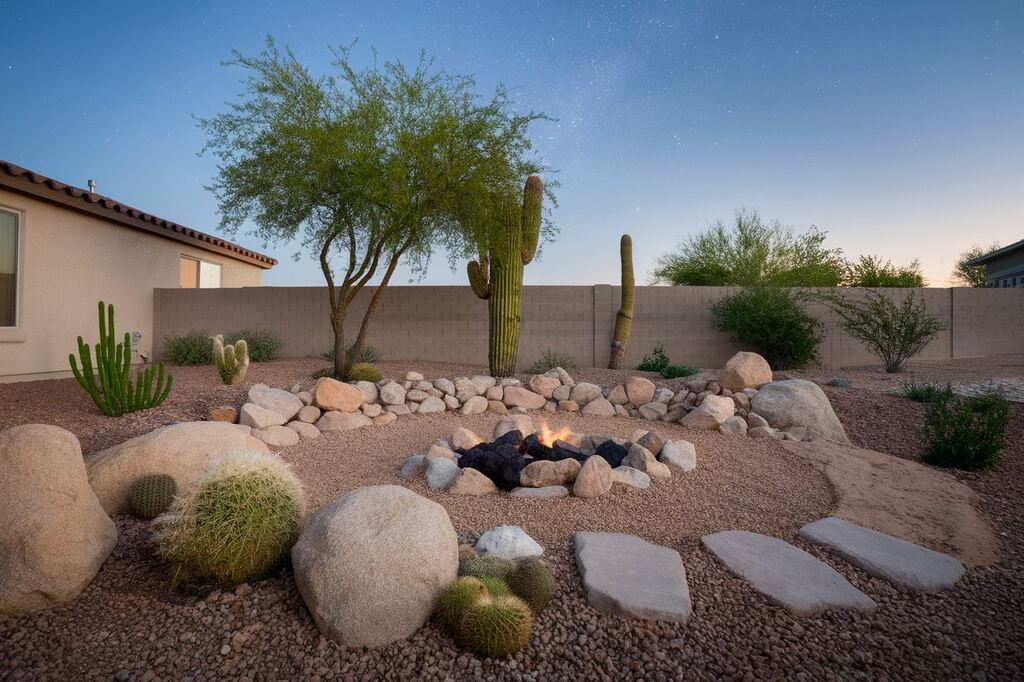In this blog, I’m exploring desert landscaping—where beauty meets sustainability in even the driest climates.
Struggling with a high-maintenance lawn in the heat? Traditional landscaping often fails in arid regions, leaving homeowners frustrated with water waste and withering plants. But with the right approach, your outdoor space can thrive with low-maintenance, drought-resistant beauty.
Let’s turn the challenges of a dry climate into a design opportunity!
15 Stunning Desert Landscaping Ideas to Transform Your Outdoor Space
Here are 15 unique desert landscaping ideas to help you create a stunning, low-maintenance outdoor space that embraces the beauty of arid environments while adding texture, color, and functionality to your yard.
1. Xeriscaping: The Ultimate Water-Efficient Landscape
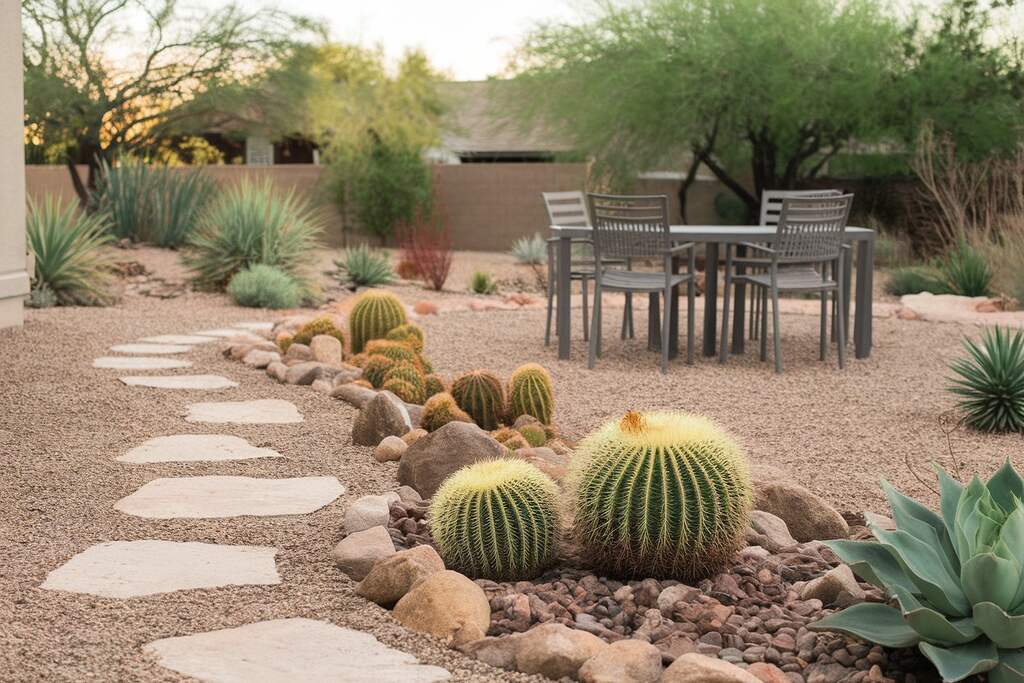
Xeriscaping is the perfect approach for those who want a beautiful, low-maintenance yard that thrives in arid conditions.
Instead of relying on traditional grass lawns that require constant watering, xeriscaping utilizes drought-tolerant plants, decorative rocks, and efficient ground covers like gravel, decomposed granite, or sand.
Native plants such as agave, yucca, and desert sage not only add visual interest but also require minimal care.
To create a cohesive look, strategically place boulders, use different shades of mulch for contrast, and incorporate pathways with flagstone or pavers.
By embracing xeriscaping, you can design a stunning, eco-friendly landscape that stays vibrant year-round while significantly reducing water usage.
2. Creating a Striking Rock Garden
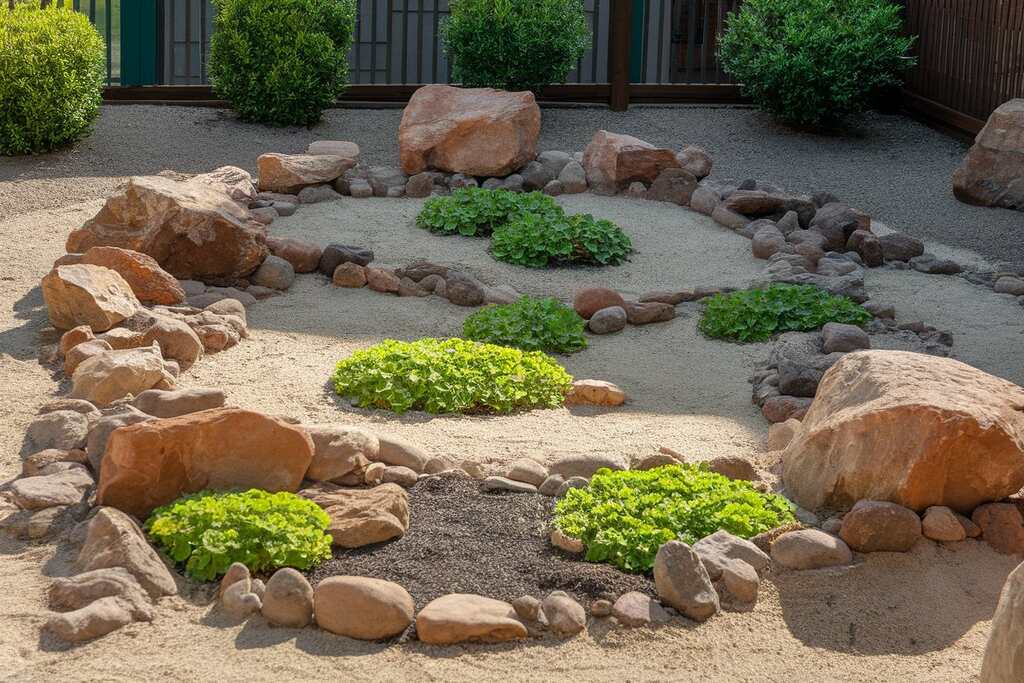
A well-designed rock garden can add texture, depth, and a unique aesthetic to your desert landscape while requiring little to no maintenance.
You can use a mix of large boulders, medium-sized river rocks, and fine gravel to craft a natural, layered effect that mimics the look of a dry riverbed or a rugged canyon.
To enhance the rock formations, introduce drought-resistant plants such as barrel cacti, aloes, and desert marigolds between the stones to create a visually appealing contrast.
Consider playing with different colors and sizes of rocks to form intricate patterns and a sense of movement throughout your garden.
A rock garden provides a beautiful and structured outdoor space that withstands harsh desert climates effortlessly.
3. A Low-Maintenance Succulent Paradise

If you’re looking for a landscape that blends elegance with minimal upkeep, a succulent garden is a fantastic choice.
Succulents come in a variety of shapes, sizes, and colors, ranging from the deep green rosettes of echeveria to the striking blue-green hues of agave.
Plant them in clusters to create a natural, organic look, or arrange them in decorative ceramic pots for a more refined aesthetic.
Consider mixing taller varieties like aloe vera with creeping succulents such as sedum to add different layers to your garden.
Since succulents store water in their leaves, they require very little irrigation, making them ideal for desert landscapes.
Whether you create a minimalist succulent bed or a vibrant arrangement in raised planters, these plants will thrive while adding undeniable beauty to your outdoor space.
4. Drought-Tolerant Wildflower Meadows
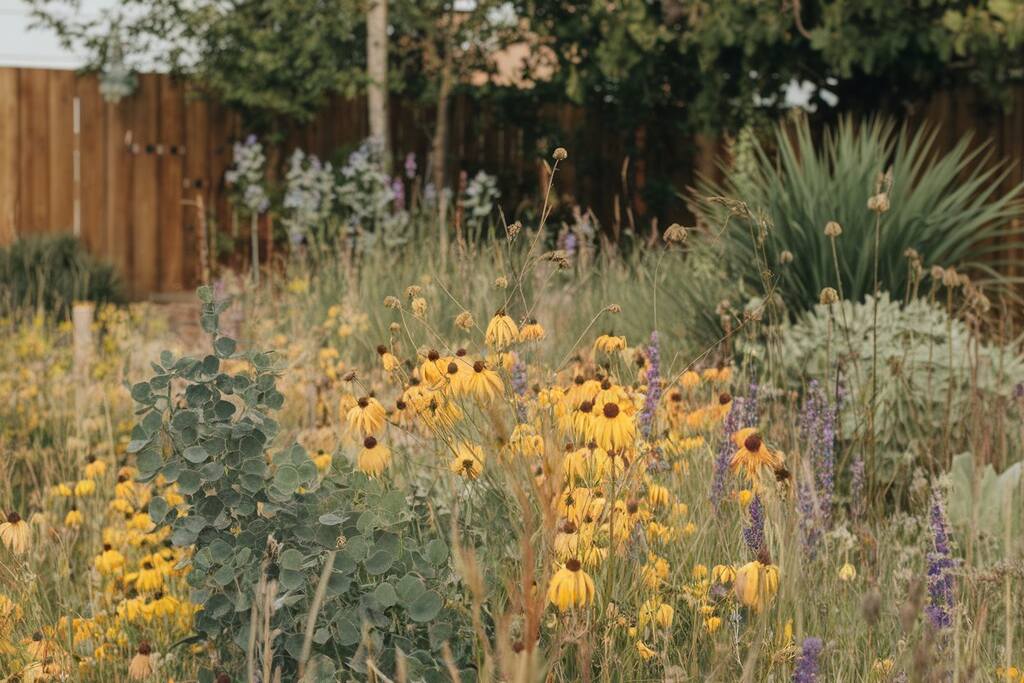
A desert landscape doesn’t have to be all rocks and cacti—it can also feature stunning bursts of color with drought-tolerant wildflowers.
Flowers such as desert marigolds, penstemon, and California poppies not only brighten up your yard but also attract pollinators like hummingbirds and butterflies, making your garden feel alive.
Instead of planting them in neat rows, allow them to grow naturally in clusters to replicate the look of a wild, untamed meadow.
You can mix different wildflowers to create seasonal color changes, ensuring that your yard remains vibrant throughout the year.
These flowers require very little water and virtually no maintenance, making them a wonderful addition to a desert-friendly landscape.
5. A Tranquil Desert Courtyard

Designing a private desert courtyard can give you a secluded retreat where you can relax and enjoy the beauty of the outdoors.
Start by replacing grass with low-maintenance hardscaping materials like stamped concrete, flagstone, or gravel.
To create a comfortable space, install a wooden pergola or a fabric shade sail that protects from the intense sun while adding architectural interest.
A well-placed fountain, even a simple recirculating water feature, can bring a sense of calm while using minimal water.
Finish the space with comfortable seating, such as weather-resistant lounge chairs or a built-in stone bench, and surround the area with potted desert plants like succulents, cacti, or desert roses to tie everything together.
A desert courtyard is a perfect way to create an inviting, peaceful outdoor sanctuary.
6. Native Cactus Garden for a True Desert Vibe
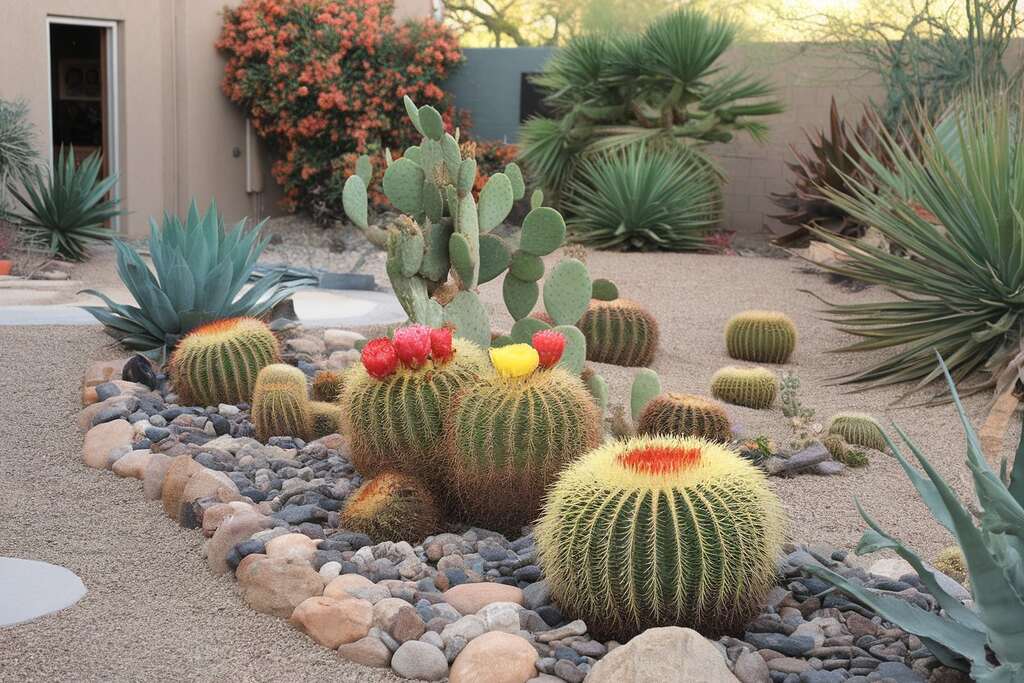
A cactus garden is one of the most dramatic and visually striking ways to embrace desert landscaping.
With their sculptural forms and diverse textures, cacti provide a bold, architectural element to any outdoor space.
You can plant a mix of species, such as towering saguaros, sprawling prickly pears, and compact golden barrel cacti, to create an eye-catching arrangement.
To enhance their impact, consider planting them in raised beds or placing them alongside large rocks and gravel pathways.
Since cacti require very little water, they thrive naturally in desert conditions, making them a hassle-free yet stunning addition to any landscape.
7. A Cozy Fire Pit with Desert Landscaping
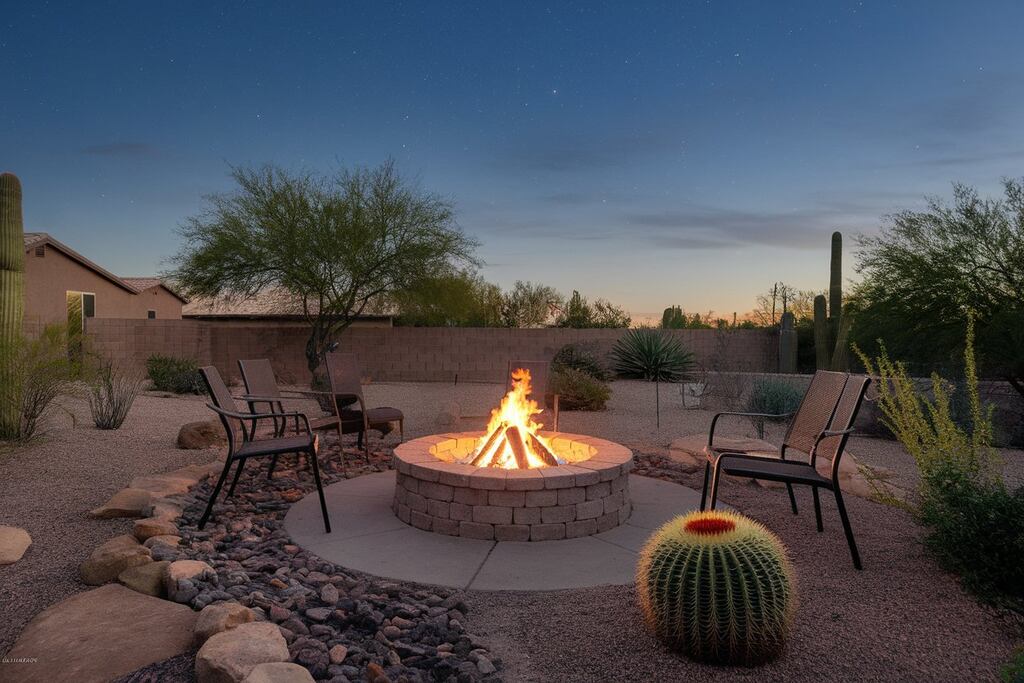
A fire pit is an excellent way to create a cozy focal point in your desert backyard while making the most of cool desert evenings.
Instead of surrounding the area with traditional grass or a wood deck, opt for a fire-resistant ground cover such as gravel, decomposed granite, or flagstone.
Arrange comfortable seating around the fire pit using natural materials like stone or weather-resistant wood.
Adding desert plants like mesquite trees, desert lavender, or ornamental grasses around the seating area enhances the natural desert aesthetic while providing a touch of greenery.
Whether you enjoy roasting marshmallows with family or simply unwinding under the stars, a fire pit adds warmth and ambiance to your landscape.
8. Water Features That Work in the Desert
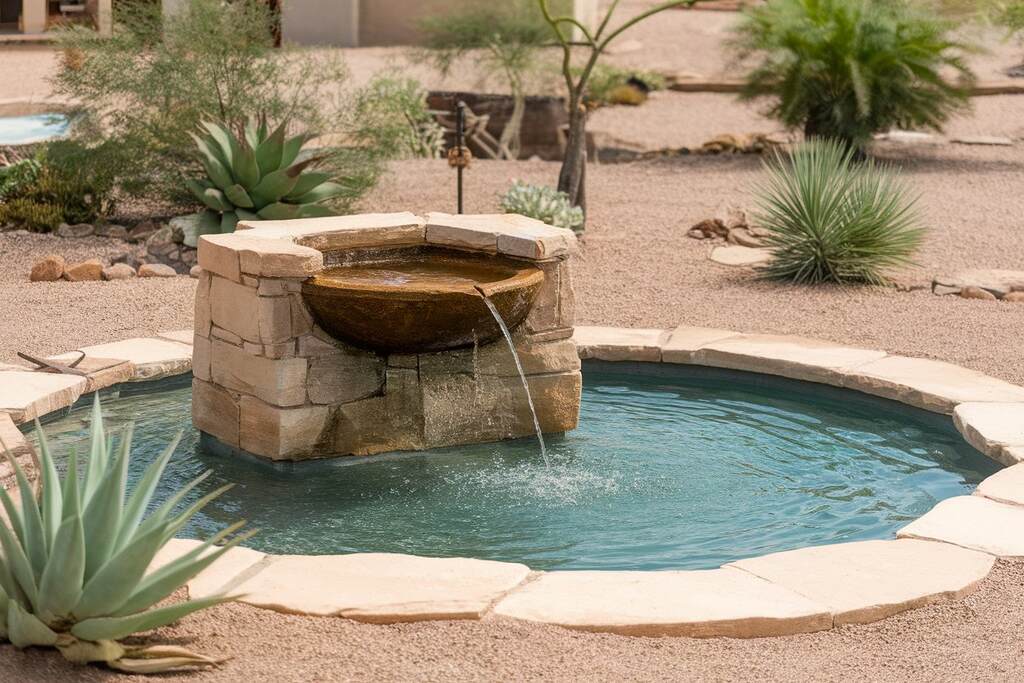
While water features may seem counterintuitive in a desert landscape, they can enhance the environment when designed thoughtfully.
Instead of large ponds or waterfalls that waste water through evaporation, consider a recirculating fountain or a bubbling rock feature that uses minimal water while creating a soothing sound.
Another great option is a dry riverbed made from pebbles and rocks, which mimics the appearance of a natural stream without requiring any water at all.
These features add movement and a sense of tranquility to your garden without compromising sustainability.
9. Desert-Themed Outdoor Seating Areas

Your outdoor seating area should blend seamlessly with your desert surroundings while providing comfort and style.
Consider incorporating natural materials such as wood, stone, and woven rattan for a rustic yet elegant look.
A shaded pergola or a retractable fabric canopy can provide much-needed relief from the sun while maintaining an open-air feel.
Using earthy-toned cushions, rugs, and throw pillows can add warmth and personality to the space while surrounding the area with potted succulents or desert grasses ensures a cohesive desert-inspired design.
10. Colorful Ceramic Planters with Desert Plants

Brightly colored ceramic planters can inject a burst of energy into a desert landscape, balancing the earthy tones of sand, stone, and cacti.
Choose vibrant hues like turquoise, deep red, or sunny yellow to contrast beautifully against the muted backdrop of your yard.
These planters can house a variety of desert plants, from cascading succulents to spiky agave, creating a visually dynamic arrangement.
By mixing different sizes and colors of planters, you can craft an artful, inviting space without requiring extensive maintenance.
11. Dry Riverbed for a Natural Flowing Element
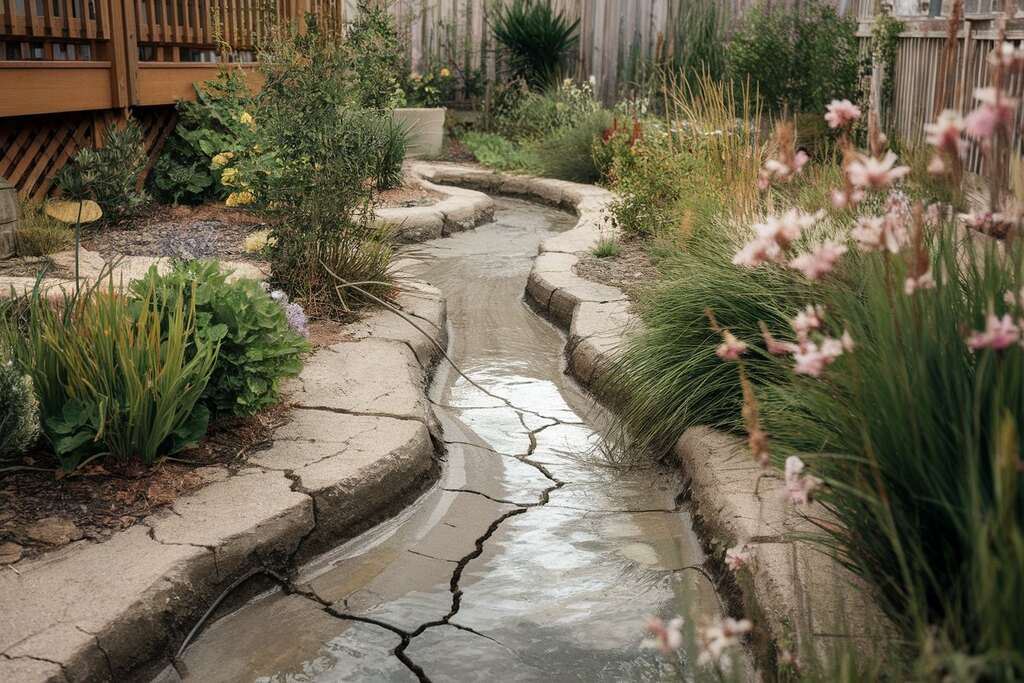
A dry riverbed is an excellent way to add movement and texture to your desert landscape without requiring water.
By arranging smooth river rocks, pebbles, and boulders in a meandering pattern, you can mimic the appearance of a naturally dried-up stream that looks both artistic and organic.
To enhance the effect, you can place drought-tolerant plants like blue fescue, Mexican feather grass, or desert lilies along the edges, giving the illusion that the riverbed once carried water.
If you want to take it a step further, install a small recirculating water feature at one end of the dry bed to create the sound of trickling water without excessive evaporation.
A dry riverbed is an eye-catching, low-maintenance feature that brings character and depth to your yard while embracing the desert aesthetic.
12. Palm Trees for a Touch of Oasis Luxury
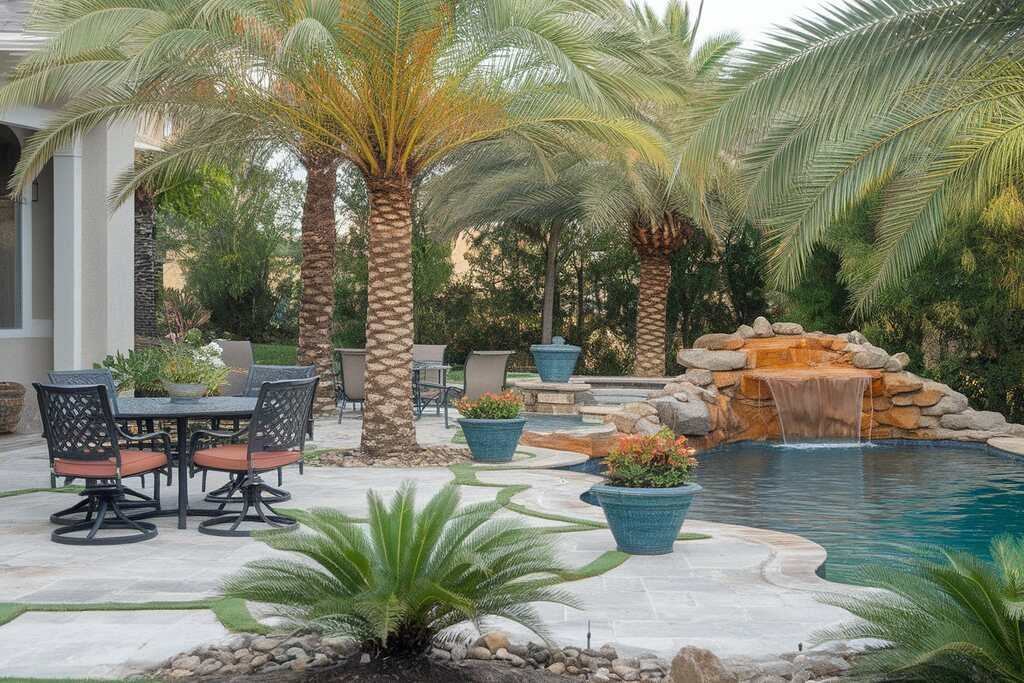
Palm trees can transform your yard into a desert paradise while offering much-needed shade in an arid environment.
Species such as the California fan palm or the Mediterranean palm are ideal for hot, dry climates, requiring minimal water while thriving in sandy soil.
These trees create a sense of vertical interest, making a landscape feel more structured and dynamic.
To enhance their oasis-like charm, you can plant them in clusters, surround them with decorative stones, and add low-growing succulents or grasses at the base.
Placing seating areas or hammocks beneath their swaying fronds offers a tranquil retreat, allowing you to enjoy the desert breeze in a naturally shaded space.
13. Natural Stone Pathways for a Seamless Desert Look

A well-designed natural stone pathway can guide visitors through your landscape while seamlessly blending with the surrounding elements.
Instead of using traditional concrete walkways, opt for materials like flagstone, decomposed granite, or large stepping stones to create an organic, rustic feel.
These pathways can lead to a seating area, fire pit, or even a secluded garden nook, adding both functionality and charm.
To make the pathway more visually appealing, place small desert plants like creeping thyme, sedum, or dwarf agave between the stones, softening the hardscape while keeping the design low-maintenance.
Whether winding through your yard or leading up to an entryway, a natural stone pathway enhances the beauty of your desert landscaping while ensuring easy navigation.
14. Solar-Powered Lights for an Enchanting Desert Glow
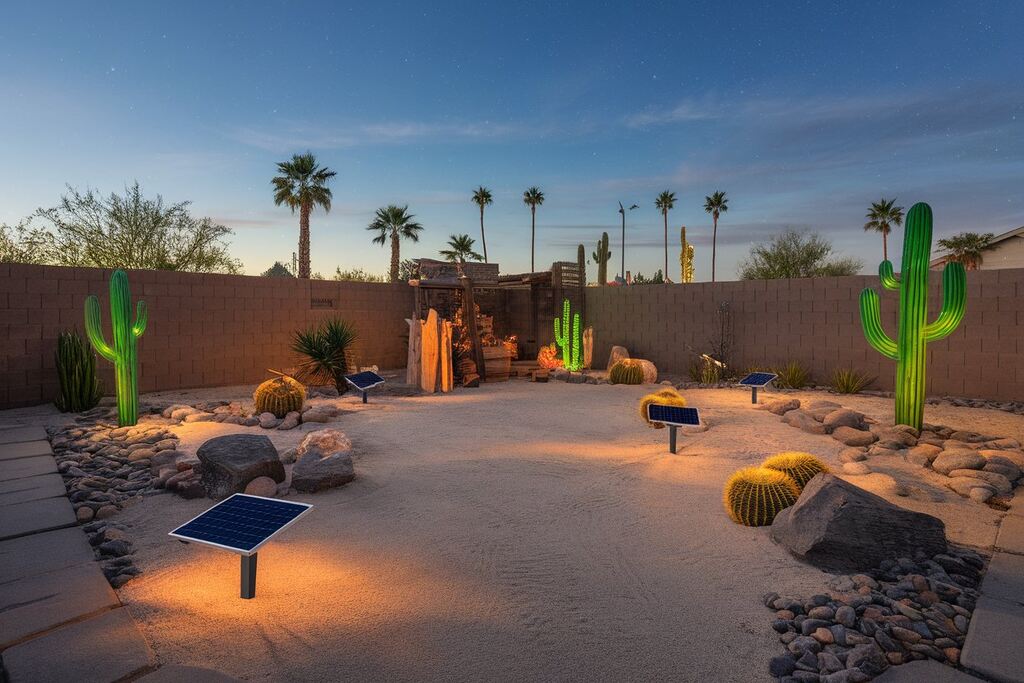
Lighting plays a crucial role in making your outdoor space feel welcoming, especially after sunset.
Solar-powered lights are an eco-friendly and cost-effective way to illuminate your desert landscape while maintaining sustainability.
You can install pathway lights along stone walkways, place uplights beneath palm trees to highlight their towering forms, or use warm-toned lanterns around seating areas to create a cozy ambiance.
String lights draped over a pergola or wrapped around cacti add a whimsical touch, transforming your yard into an enchanting retreat at night.
Since solar lights charge during the day and require no wiring, they are incredibly easy to install and maintain, making them a perfect addition to any desert-inspired outdoor space.
15. Outdoor Dining Area with a Rustic Desert Vibe
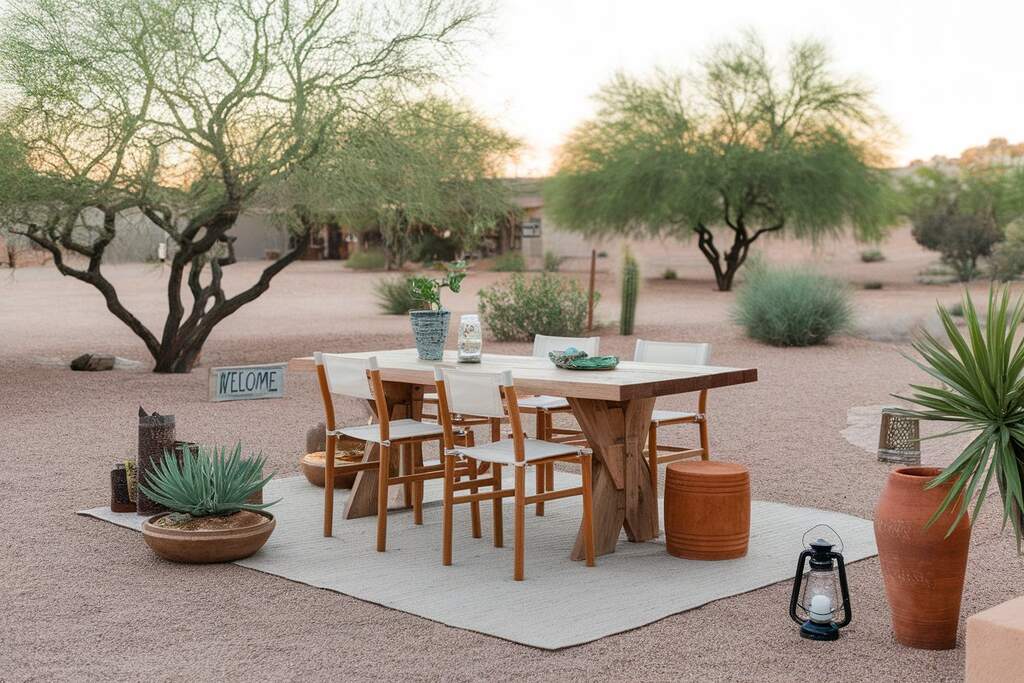
An outdoor dining area allows you to fully embrace the beauty of desert living while creating a stylish and comfortable space for entertaining.
A rustic wooden dining table paired with woven rattan chairs or stone benches gives the setting a natural, earthy appeal.
To provide shade and comfort, install a pergola or a large fabric canopy that blends harmoniously with the landscape.
Decorate the table with terracotta planters filled with cacti or succulents, and use woven textiles like Southwestern-style rugs or macramé table runners to add warmth and character.
A built-in barbecue grill, outdoor pizza oven, or fire pit nearby can make outdoor dining even more enjoyable.
Whether you’re hosting guests or enjoying a quiet meal under the stars, a thoughtfully designed outdoor dining space will elevate your desert landscape and create a welcoming atmosphere.
Conclusion
Transforming your yard with desert landscaping doesn’t mean sacrificing beauty, comfort, or creativity.
Thoughtful features like natural stone pathways, solar lighting, and water-efficient designs ensure that your landscape remains sustainable while still being a stunning retreat. Whether you’re looking to craft a peaceful sanctuary or a stylish entertaining space, these desert landscaping ideas will help you embrace the natural beauty of the desert while minimizing water usage and maintenance.
FAQs
What are the best plants for a desert landscape?
Drought-tolerant plants like agave, yucca, cacti, succulents, desert marigolds, and ornamental grasses are ideal for desert landscaping as they require minimal water and thrive in hot, dry conditions.
How can I make my desert yard more colorful?
Incorporate flowering desert plants like penstemon, California poppies, and desert hibiscus. Use colorful ceramic planters and natural stone arrangements to create contrast against neutral desert tones.
What is the best ground cover for a desert yard?
Gravel, decomposed granite, crushed stone, and mulch are excellent ground cover options that help retain moisture, reduce erosion, and enhance the overall look of a desert landscape.
How can I create shade in a desert landscape?
You can add shade by planting palm trees or desert-friendly trees, installing pergolas, using fabric shade sails, or incorporating outdoor umbrellas and canopies in seating areas.
Are desert landscapes expensive to maintain?
No, desert landscapes are generally low-maintenance and cost-effective. Since they use drought-resistant plants and hardscaping elements, they require little watering, pruning, or upkeep compared to traditional lawns.

